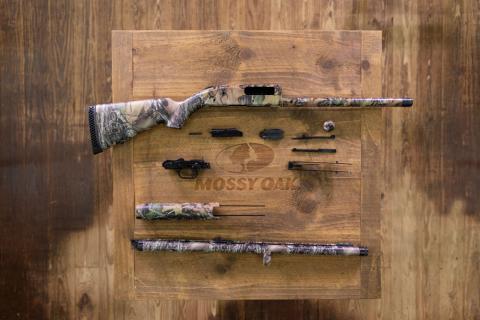Connections
Ron Jolly, Photos by Tes Randle Jolly
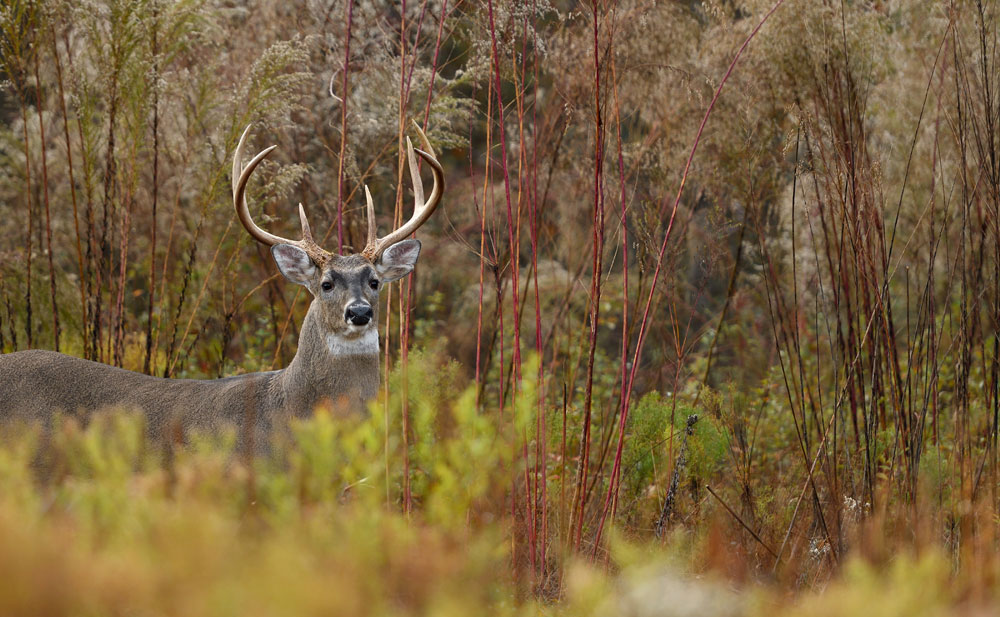
The big buck stepped out of tall grass into a planted pine corridor established to provide a travel route between two hardwood bottoms. Before I could get my binoculars on him he disappeared from sight. Even though I only had a quick look from 150 yards away I knew the buck and he was definitely on my shoot list. This was the first time eyes were laid on this buck, but trail camera images revealed he frequented the farm.
When he was a three-year old he sported a nine point 17” spread rack. The next year his nine-point rack was wider and heavier so I named him “Niner” and put him on the shoot list. This year he was five years old and trail camera photos revealed he was possibly the biggest buck anyone had seen on the farm.
I was hunting from a ground blind positioned on the northeast corner of the pine corridor. The wind was northwest so I knew I at least had a chance. It all hinged upon whether he followed the corridor or cut across the four-acre food plot on the south side.
Minutes passed as I frantically searched for Niner. I thought I would be able to see him in the pine corridor well before he reached the end. Suddenly he popped out of the pines headed for the hardwoods. How he got past me I will never know. I quickly raised my gun, took aim and pulled the trigger, when he was only feet from entering the woods and safety. It happened so fast I didn’t have time to get excited. Then the adrenaline kicked in. My mind raced as I questioned my aim and the shot. I waited ten minutes and with daylight fading fast, I made my way to where he’d stood.
“IT’S ABOUT CREATING A LEGACY FOR ALL FUTURE GENERATIONS. SUBSCRIBE TODAY!”
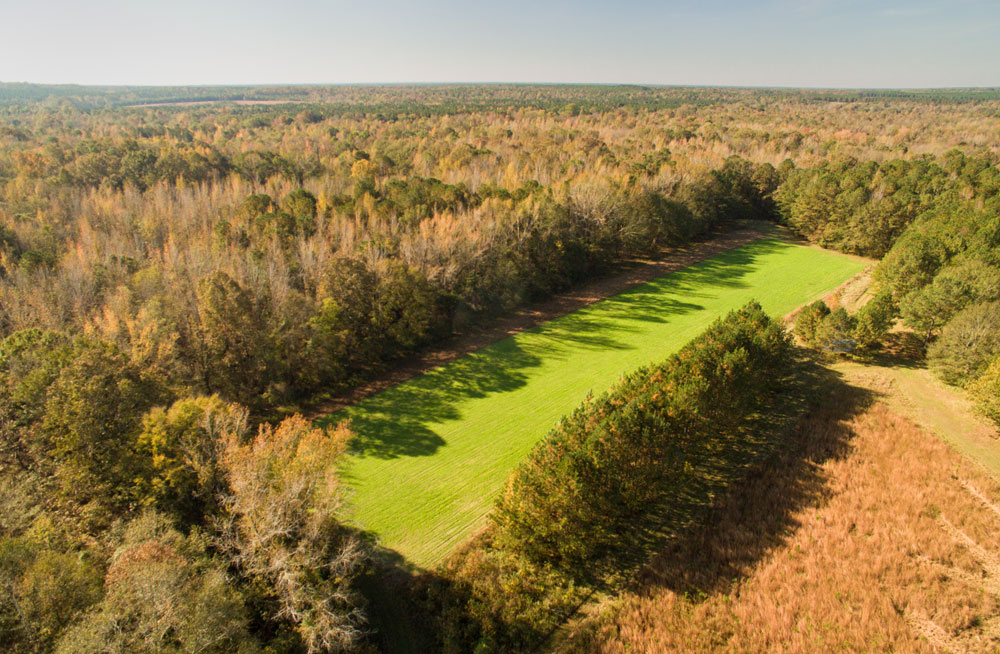
Before I got there, I saw his white belly shining in the darkness of the hardwoods. When I reached him I was shocked. This was definitely the biggest buck anyone had tagged to date on the farm. Later his rack measured an inside spread of 21 inches. He had nine points with good mass, long beams and grossed just north of 145 inches. The scales read 240 pounds.
Owning a piece of property and managing it for wildlife is every gamekeeper’s dream. My wife Tes, and I, realized that dream with the purchase of our east-central Alabama farm. The diverse habitat of swampland, upland timber, hardwood bottomland and open pasture made the property very attractive to deer, turkeys, squirrels, rabbits and a wide variety of birds, reptiles and small mammals.
Say the word “conservation” and you open a conversation that is very popular in the United States today. In fact, conservation means something to almost every landowner or manager and the reason is clear. Sound conservation practices have changed the landscape and produced record numbers of deer, elk, waterfowl and turkeys.
Our goal was to maximize the productivity of our land for turkeys, deer and all wildlife. Early on, we recognized the big obstacle to achieving maximum productivity was the pasture land that comprised almost one-fourth of the acreage.
To solve the problem, we began converting pasture into wildlife habitat in small block increments. First we planted 30 acres of loblolly pines. Several years later we planted another 20 acres of pines. Then we planted 10 acres of mixed oak varieties and another 12 acres were developed into food plots. The final 20 acres were lightly tilled and allowed to naturally revegetate and a 70-foot wide strip of loblolly pines were planted to create a corridor between grassland and a big food plot.
This process took 10 years to complete but today the entire farm is “wildlife friendly.” As a result of this work and planning we created corridors that wildlife utilize to traverse the property without being exposed. Within them are bedding and nesting cover and natural food sources. This is where Niner felt comfortable enough to traverse the farm during daylight hours.
What Is a “Wildlife Corridor?”
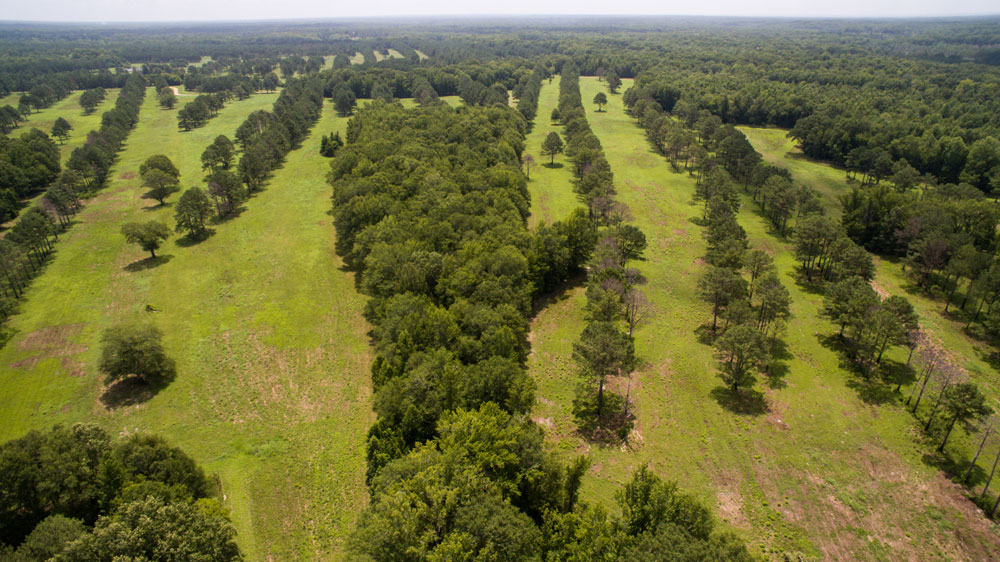
One of the greatest threats to wildlife populations is “habitat fragmentation.” Human expansion, along with agricultural and urban development are destroying large blocks of wildlife habitat. Wildlife corridors provide a balance between expanding human populations by creating habitat beneficial to wildlife and connecting fragmented areas. They also increase survival of wildlife by increasing food sources, providing cover and decreasing the chance of predation.
A wildlife corridor is a feature that connects two or more isolated habitats. They can consist of trees, vegetation, or water. Corridors can be created or exist naturally. They provide safe travel for wildlife from one habitat to another.
Locations for wildlife corridors are most easily determined by studying aerial photographs or detailed maps of properties or landscapes. The goal is to determine how isolated blocks of habitat can be connected to other habitat by establishing cover between them or through them.
Types of Corridors
Woodland—Woodland corridors are planted or occur as naturally regenerated trees that connect one woodlot to another. They can be trees or shrubs similar to the blocks of timber they connect or different species suitable to the area. The wider the corridor, the better, but a minimum of 25 feet is recommended. We planted strips of loblolly pines to connect timber stands on our farm. Pines grow fast and provide cover in a short period of time. Later they can be thinned to allow sunlight to reach the ground and periodic burns stimulate the growth of native vegetation.
Grassland—Grassland corridors are established along field borders, fencerows, waterways or as entire fields. They can be planted into native warm season grasses such as big bluestem or Indian grass, or others native to your area. Beneficial cool season grasses include timothy and orchard grass. Legumes and forbs such as wildflowers are also valuable. Check with your extension agent for guidance.
Grassland corridors can also be established by allowing native grasses and vegetation to regenerate on their own. Plowing, disking or in some cases the use of herbicide releases the native seed bank and hastens the process. A minimum width of 25 feet is recommended and again, the wider the better.
“IF YOU LOVE WILDLIFE AND WANT TO IMPROVE HABITAT SUBSCRIBE TODAY!”
Shrub-land—Shrub-lands are not often considered vital wildlife habitat. In reality, many species, including bobwhite quail, whitetail deer, rabbits and numerous species of birds and small mammals, depend on thickets for shelter and cover. Cedar thickets, abandoned fields and cutovers are good examples of shrub-lands.
To establish a shrub-land corridor, plant dogwoods, crabapples and viburnums or species native to your area. Mossy Oak Nativ Nurseries is an excellent source for trees, native seeds and grasses. Open ground left untilled or mowed will naturally populate with saplings in 3-5 years. Manage with periodic prescribed burns, disking and/or mowing.
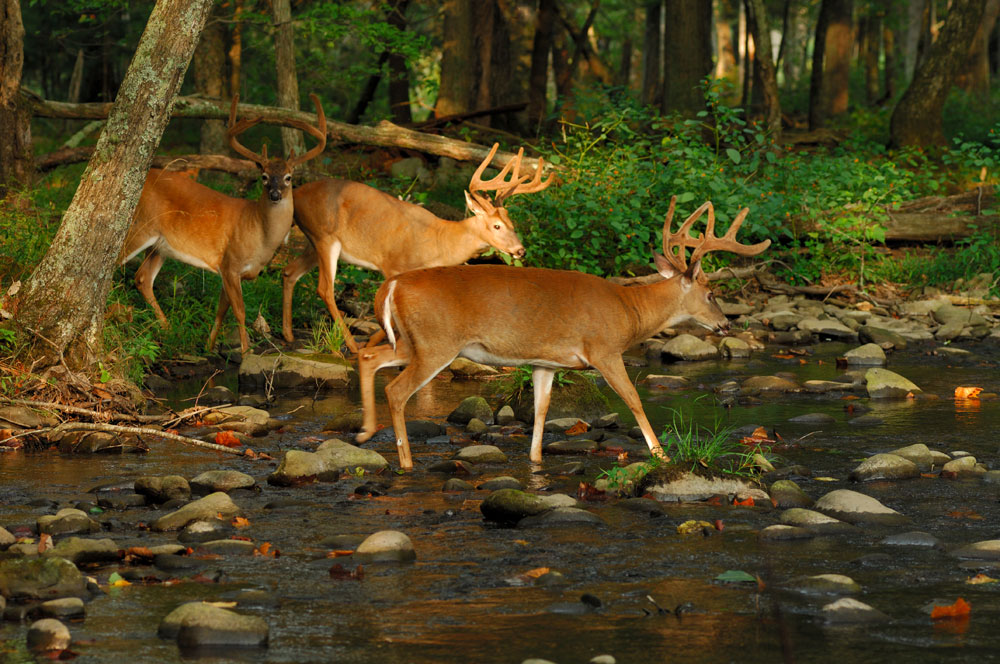
Wetland—Rivers, streams and wet drains serve as natural corridors for all sorts of wildlife. These corridors, especially their banks and channels, should simply remain undisturbed.
In most cases it is cost prohibitive or impractical to connect swamps, sloughs or wetlands with identical habitat. Woodland, grassland or shrub-land corridors are sufficient. Before establishing one of the corridors in wetlands choose plants that tolerate the wetland conditions. The easy way to establish a wetland corridor is to mark off the desired width of your corridor and allow it to naturally regenerate. This will insure plant species suited to the soil will become established.
These are the widely accepted types of corridors. We have three of the four on our farm. The woodland corridor is a 70-foot wide pine stand that connects mixed hardwoods and pines. To manage the strip, the pines will be thinned before they shade out understory growth. This will allow sunlight and new annual growth.
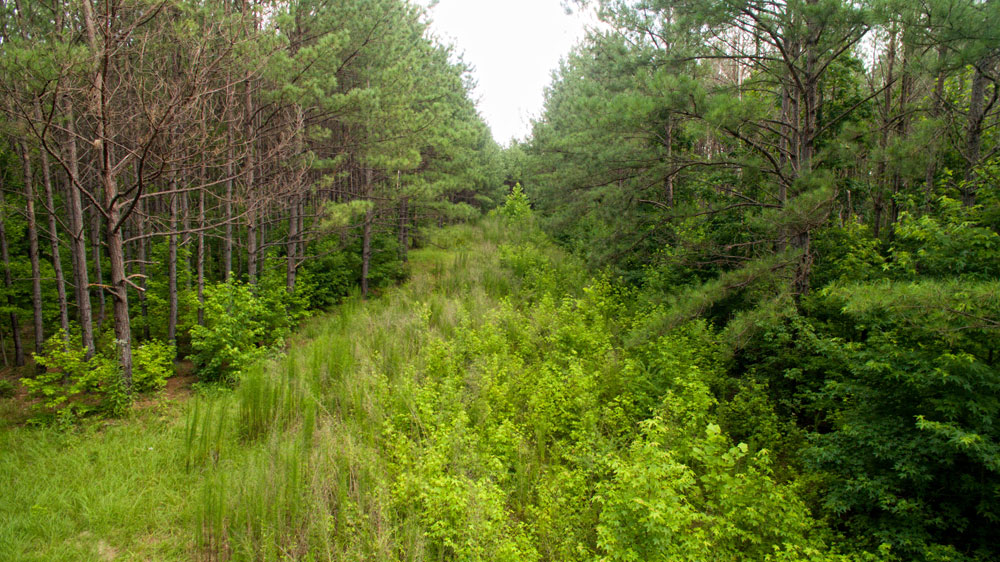
The grassland corridor is old pasture land that was allowed to regenerate natural growth of pines, shrubs and grasses. It is approximately 300 feet wide and provides an abundance of native forage, browse and cover for wildlife moving between two pine plantations. We manage the corridor year to year with prescribed fire during late winter one year, and mowing in summer the next (after turkey nesting and before fawn drop).
The wetland corridor is a strip of mixed pine and hardwood timber on either side of a small creek that runs from planted pines to a hardwood timber bottomland. If this strip needs enhancement, we will thin the timber along that drainage to allow more understory growth.
Other corridors are established along property line fences by allowing understory shrubs, briars and saplings to grow unchecked on our side of the fence. Field edges are feathered and allowed to grow natural weeds, grasses and briars. Open strips were left when planting pines, allowing them to revegetate in native plants. When the pines are in mid-rotation there is practically no understory and deer tend to avoid them. These strips encourage deer to cross the plantation via the brushy, grassy strip, so these “hallway” strips are managed with mowing and prescribed fire. All these features offer wildlife increased safe travel ways, native food sources, escape cover and nesting habitat.
“BECOMING A GAMEKEEPER IS NOT JUST THE BEST WAY TO PRODUCE GREAT HUNTING… IT’S THE BEST LIFE! SUBSCRIBE TODAY.”
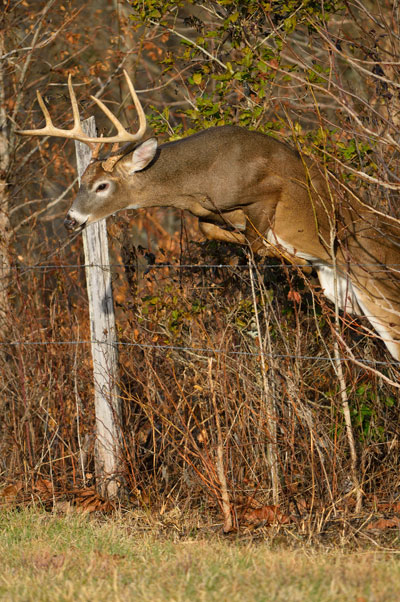
through open areas. Shrubs, briars and grasses left to grow
along fencerows on one or both sides provide browse and
security cover that encourages deer to use them as a
bridge from one habitat to another.
Hunting Wildlife Corridors
In addition to benefitting many species of wildlife, corridors offer great opportunities for hunters. Cottontail rabbits literally live in corridor habitat, as do bobwhite quail and many non-game birds. Turkeys utilize them as nesting cover and gobblers often troll their edges when hens are on the nest.
Deer hunters can take advantage of corridors by positioning stands or blinds where they can intercept deer traveling from one area to another. I find them especially productive just prior to, during and just after the rut.
They are excellent locations for trail cameras. Over time, obvious trails are established. These trails show where most deer travel through the corridor. Place your cameras on these trails. Use the reconnaissance evidence from the trail cameras to determine what is using the corridor and when. Play the wind and place a pop up ground blind or treestand for a favorable wind along the corridor. It can be a waiting game. Patience is key and the reward may be a buck like Niner.
Summary
There are countless benefits of having wildlife corridors on your property. The key is understanding where they should be and creating a plan that develops practical habitat that is wildlife friendly. Understand, this takes time. In our case it took 10 years to convert pasture land that comprised almost a quarter of our acreage into productive wildlife habitat. With proper management and construction, corridors become permanent fixtures that help maximize the potential of your property by connecting one viable habitat to another.















